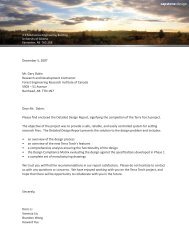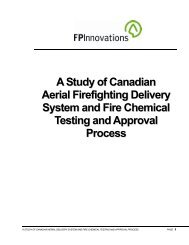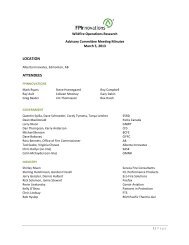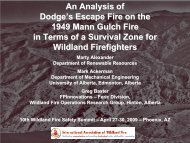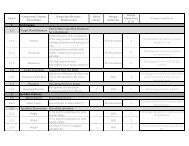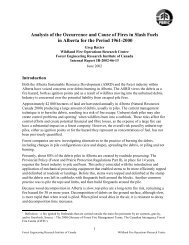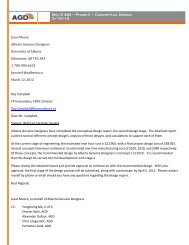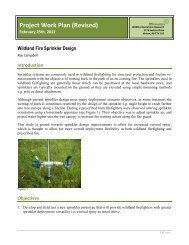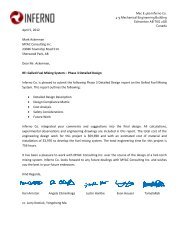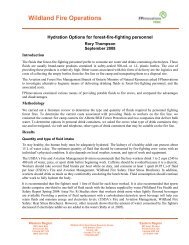Report: Chisholm wildfire entrapment investigation - FPInnovations ...
Report: Chisholm wildfire entrapment investigation - FPInnovations ...
Report: Chisholm wildfire entrapment investigation - FPInnovations ...
Create successful ePaper yourself
Turn your PDF publications into a flip-book with our unique Google optimized e-Paper software.
Fire Behaviour Analysis<br />
In the Fire Behaviour Forecast (Forecast #2) for Sunday May 27, 2001 the Fire Behaviour Specialist assigned to Fire<br />
#63 noted (the Fire Behaviour Forecast that was issued is included in Appendix III):<br />
• all fuels were at a critical state of dryness;<br />
• Fire Weather Indices were: FFMC 90, DMC 95, DC 380, ISI 15, BUI 117, FWI 43;<br />
• forecast winds (SE 30 gusting to 60 km/h) would result in intense burning conditions in all fuel<br />
types;<br />
• crown fires were expected in all coniferous fuel types (C2), while deciduous stands (M1) and<br />
grassy fuels (O1b) would support very vigorous surface fires;<br />
• long range spotting would occur;<br />
• the fire would make significant excursions (i.e. “runs”); and,<br />
• fire behaviour would be erratic.<br />
Documented Fire Behaviour for May 27, 2001<br />
Rates of spread in metres/minute in boreal spruce (C2) fuel types with some cured grass (O1b):<br />
Time<br />
Rate of Spread<br />
1600 -1800 54 m/min (3.2 km/h)<br />
1800 - 2000 54 m/min (3.2 km/h)<br />
2000 - 2021 76 m/min (4.6 km/h)<br />
Incident Description<br />
On the morning of May 27, 2001, fourteen people were instructed to mop-up 30 – 50 metres inside a dozer guard<br />
that had been established along the eastern flank of Sector 5, Division 2, Fire #63. The fourteen personnel were<br />
comprised of: one (1) three-person Initial Attack crew from BC, eight (8) Type III Emergency Firefighters from<br />
Alberta, and three (3) equipment operators (two Nodwells and one Buggy ground tanker). Only the three Initial<br />
Attack firefighters from British Columbia were carrying fire shelters. The dozer guard the firefighters were working<br />
on had been tight-lined and it had not yet been secured.<br />
Bucketing commenced on the sector at approximately 0730 hours and spots were noted outside the dozer guard at<br />
approximately 0846 hours. These spot fires were actioned by helicopters with buckets. As the day progressed,<br />
firefighters and equipment proceeded south along the dozer guard carrying out their assignment. Between 1130 and<br />
1200 hours, the Division Boss contacted the Crew Boss and instructed him to proceed approximately 1 kilometer<br />
further south along the dozer guard to evaluate hotspots at that location. The crew then left the safety of their anchor<br />
point and proceeded south to the hotspots. Safety Zones and Escape Routes were discussed over the radio by the<br />
Sector Boss and the Crew Boss. By 1400 hours the Sector Boss and Crew Bosses realized that the burned area<br />
could no longer be considered a “Safety Zone” due to the risk of trees falling as a result of strong winds and<br />
complete duff consumption at the base of trees.<br />
At approximately 1432 hours, a flare-up to the north of the crew blocked access to their original anchor point. By<br />
this time, the ground water tankers being used by the crew were nearly empty and unable to return north to be<br />
refilled. By 1500 hours the crew had traveled south and established a new Safety Zone. Trees laying across the<br />
guard to the south prevented the Sector Boss from reaching the crew via ground transportation, and he requested a<br />
helicopter Bird Dog Officer (BDO) to check on the crew between 1532 and 1535 hours.<br />
Page 8 of 61



